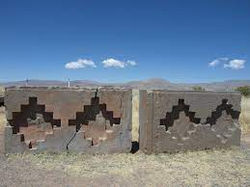THE ENERGY OF THE CHAKANA OR ANDEAN CROSS
With a chakana stone, you are calling in more connection between all layers of your life; mind, body, and spirit. Every shape, symbol, and stone to the Quechua people has great meaning.
In the Quechua language, “chakana” is a blend of two words “chaka” meaning bridge and “hanan” meaning tall. The Inca believed that the Chakana was a bridge between the three worlds; the world of Gods or what we think of as Heaven, the world of Man; or Earth, and the world of the Dead; or the spiritual realm, which is why each side of the chakana is a 3-stepped pyramid.
The Incas believed that everything is connected to Mother Earth, or Pachamama, and she is in the center of everything with only a circular hole cut out in the middle representing the Sun god, or a portal to the unknown.
 |  |  |
|---|
CHAKANA
THE INCAN CROSS
The stepped cross with four corners, ridged with three steps each is called the Incan cross or “Chacana”. The Chakana symbolizes the dynamic between the universe and the life it contains. Each of the three steps of one corner is believed to have meaning:
The first quarter of the cross represents energetic tiers or worlds:
The lower world (Uqhu Pacha) represented the underworld and death
The middle world (Kay Pacha) represented the world of human life
The upper world (Hanan Pacha) included the stars, celestial beings and gods
The second quarter represents their revered animals, corresponding to these worlds:
the snake, living underground, represented the lower world
the puma, a powerful land animal represented the middle world
the condor represented the upper world in the sky
The third quarter symbolizes 3 commandments of Incas:
don’t steal
don’t lie
don’t be lazy
The fourth – the human principals:
love and well doing
knowledge
work
The four arms of the chakana designate the four provinces of Incan Empire (Tawantinsuyu): Chinchaysuyo, Kollasuyo, Antisuyo and Contisuyo.
The ends of the Incan chakana also represent the four main stars of the Southern Cross, an important constellation for the Inca, who believed that was the centre of the Universe.
Besides, the four “arms” of any chakana represent the four 'classical elements' of earth, air, water and fire; the four directions of the compass and four seasons: winter, spring, summer and autumn.

THE SEVEN CHAKRAS AND THEIR COLOURS
How Reiki Works with the Chakra System
By Chris Pichereau, Abshier House
Reiki is an ancient form of Japanese healing that is practiced by many practitioners around the world. There is an omnipotent energy that gives life to every living thing, and the Japanese call this “Ki.” It is also known as Chi by the Chinese, Prana by a number of Asian cultures, and most of the western world refers to it as the Holy Spirit.
Chakras, a Sanskrit language word meaning “wheel of life,” are energy centers found throughout the body. The position of each of the major chakras corresponds with an endocrine gland controlling hormonal balance. These chakras are located at the base of the spine (root chakra), between the genitals and naval (sacral chakra), a couple of inches above the naval (solar plexus chakra), the center of the chest (heart chakra), middle of the neck (throat chakra), just above the brow area (third-eye chakra), and top of the head (crown chakra).
Chakras represent specific aspects of the conscious being and their main functions and characteristics are as follows:
Root chakra
Color: Red
Body Parts: Adrenal glands, kidneys, spinal column, leg bones
Function: Grounds you physically.
Imbalance: Afraid of life, feel victimized, selfishness, prone to violence; low back, feet, and leg pain
Sacral chakra
Color: Orange
Body parts: Gonads, prostate gland, reproductive system, spleen, bladder
Function: Deals with creativity, sexuality, and emotions
Imbalance: Overuse of food, sex, or alcohol; sexual or reproductive disorders; confusion, jealousy, and self-esteem issues.
Solar plexus chakra
Color: Yellow
Body parts: Pancreas, liver, digestive tract, stomach, spleen, gall bladder, autonomic nervous system
Function: Intellect and is known as the seat of personal power
Imbalance: Insecurity about financial matters; need to control others; digestive disorders
Heart chakra
Color: Green
Body parts: Thymus gland, heart, lower lungs, circulatory system, skin, hands
Function: Bridge between the physical and spiritual worlds; center of emotional well-being and love
Imbalance: Sad feelings, fear, anger, and can lead to heart disease
Throat chakra
Color: Blue
Body parts: Thyroid gland, throat and jaw areas, lungs, vocal cords, digestive tract
Function: Communication and mental creativity
Imbalance: Communication breakdowns, overindulgences in eating and drinking to keep from speaking the truth; respiratory diseases, dental problems, and low self-esteem as well as anger, hostility, and resentment
Third-eye chakra
Color: Indigo
Body parts: Pituitary gland, lower brain, left eye, ears, nose, central nervous system
Function: Intuition and clairvoyance; ability to visualize and manifest
Imbalance: Fear of dreams, headaches, insomnia, anxiety, and depression
Crown chakra
Color: Violet
Body parts: Pineal gland, upper brain, right eye
Function: Direct connection to spirit
Imbalance: Loneliness, need to compare ourselves to others, fear of death
By placing the hands over the corresponding seven major chakra centers that are experiencing any of the imbalances mentioned and performing Reiki, these centers can be rebalanced leading to better health.
Reiki can be effectively performed only by someone who has been trained and attuned by a Reiki Master.

